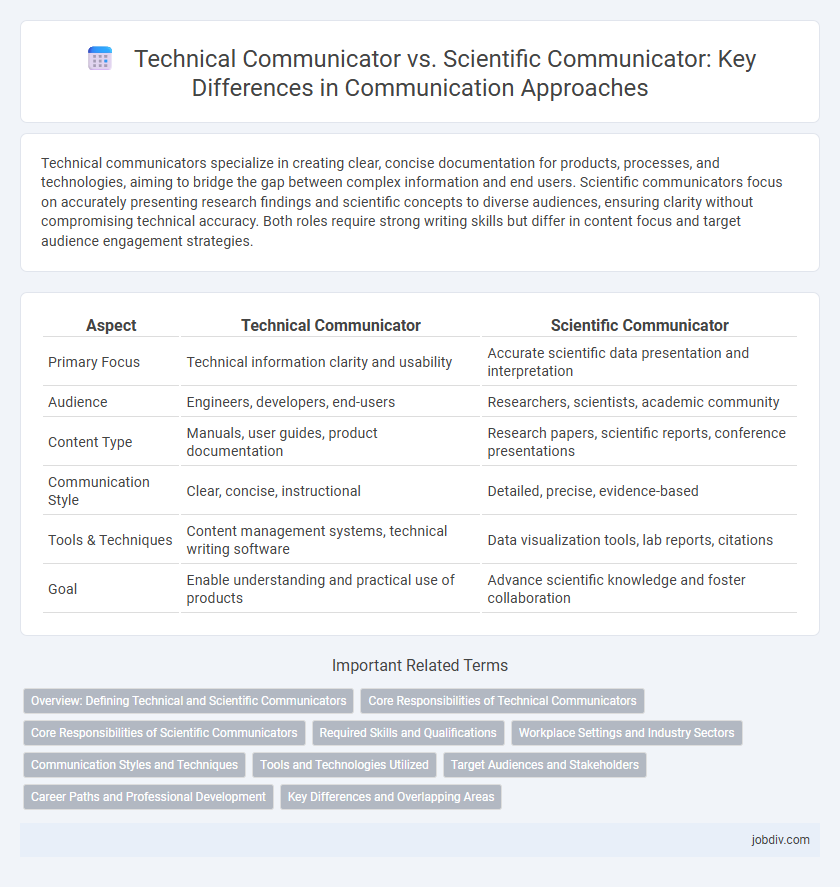Technical communicators specialize in creating clear, concise documentation for products, processes, and technologies, aiming to bridge the gap between complex information and end users. Scientific communicators focus on accurately presenting research findings and scientific concepts to diverse audiences, ensuring clarity without compromising technical accuracy. Both roles require strong writing skills but differ in content focus and target audience engagement strategies.
Table of Comparison
| Aspect | Technical Communicator | Scientific Communicator |
|---|---|---|
| Primary Focus | Technical information clarity and usability | Accurate scientific data presentation and interpretation |
| Audience | Engineers, developers, end-users | Researchers, scientists, academic community |
| Content Type | Manuals, user guides, product documentation | Research papers, scientific reports, conference presentations |
| Communication Style | Clear, concise, instructional | Detailed, precise, evidence-based |
| Tools & Techniques | Content management systems, technical writing software | Data visualization tools, lab reports, citations |
| Goal | Enable understanding and practical use of products | Advance scientific knowledge and foster collaboration |
Overview: Defining Technical and Scientific Communicators
Technical communicators specialize in conveying complex technical information clearly to diverse audiences, often focusing on user manuals, product documentation, and software guides. Scientific communicators, on the other hand, translate scientific research and data into accessible language for both expert peers and the general public, emphasizing accuracy and clarity in scientific findings. Both roles require strong writing skills but differ primarily in content focus and target audiences within technical and scientific domains.
Core Responsibilities of Technical Communicators
Technical communicators specialize in creating clear, concise manuals, user guides, and documentation that translate complex technical information into accessible content for diverse audiences. Their core responsibilities include analyzing user needs, collaborating with engineers and developers, and ensuring accuracy and usability in instructions and product descriptions. Unlike scientific communicators who focus on research dissemination, technical communicators emphasize practical application and user experience in technology communication.
Core Responsibilities of Scientific Communicators
Scientific communicators specialize in translating complex scientific data and research findings into clear, accurate, and accessible content for diverse audiences, including scientists, policymakers, and the public. They are responsible for disseminating technical information through various media such as research papers, presentations, educational materials, and digital content, ensuring the integrity and precision of scientific language. Their core responsibilities also include facilitating understanding of scientific concepts, promoting scientific literacy, and supporting informed decision-making in science-related fields.
Required Skills and Qualifications
Technical communicators require expertise in conveying complex technical information clearly to diverse audiences, proficiency in tools like XML, HTML, and content management systems, and strong analytical skills. Scientific communicators must possess a deep understanding of scientific concepts, the ability to interpret and present research data accurately, and often hold advanced degrees in relevant scientific fields. Both roles demand excellent writing, editing, and audience adaptation skills, but scientific communicators emphasize subject-matter expertise while technical communicators focus on clarity and usability.
Workplace Settings and Industry Sectors
Technical communicators excel in industries such as information technology, engineering, and manufacturing, producing user manuals, product documentation, and procedural guides that enhance operational efficiency. Scientific communicators thrive in research institutions, healthcare, and environmental sectors, translating complex scientific data into accessible reports, journal articles, and grant proposals to support academic and clinical advancements. Both roles prioritize clarity and accuracy but differ in audience focus and content specialization within workplace settings.
Communication Styles and Techniques
Technical communicators specialize in creating clear, concise instructions and manuals that simplify complex technical information for non-expert audiences, using structured formats like bullet points and visual aids. Scientific communicators focus on conveying research findings and scientific concepts to both expert and general audiences, often employing precise terminology, data visualization, and narrative explanations to enhance comprehension and engagement. Both styles prioritize clarity and accuracy but differ in audience focus and the complexity of language used.
Tools and Technologies Utilized
Technical communicators primarily use content management systems (CMS), authoring software like MadCap Flare and Adobe FrameMaker, and multimedia tools to create user manuals, software guides, and instructional content. Scientific communicators rely on data visualization software such as GraphPad Prism and MATLAB, reference management tools like EndNote, and collaborative platforms like Overleaf for LaTeX document preparation to accurately present research findings and complex scientific data. Both roles leverage digital communication technologies but tailor their tools to suit the specificity of technical instructions or scientific evidence representation.
Target Audiences and Stakeholders
Technical communicators primarily target industry professionals, engineers, and end-users requiring clear instructions or product information, ensuring content is precise and accessible for practical application. Scientific communicators focus on researchers, academics, and policymakers, emphasizing accuracy and depth to advance knowledge and influence scientific discourse. Both roles engage stakeholders differently, with technical communicators prioritizing usability and operational clarity, while scientific communicators address credibility and data-driven insights.
Career Paths and Professional Development
Technical communicators specialize in creating clear, user-focused documentation such as manuals, guides, and software instructions, often advancing through roles in information design, content strategy, and usability testing. Scientific communicators focus on translating complex research findings into accessible formats for diverse audiences, with career progression involving roles in science writing, public relations for research institutions, and science policy advisement. Both career paths emphasize continuous skill development in writing, audience analysis, and adapting to emerging communication technologies.
Key Differences and Overlapping Areas
Technical communicators specialize in creating user manuals, product documentation, and technical guides aimed at end-users or technicians, emphasizing clarity and usability for practical applications. Scientific communicators focus on presenting research findings, scientific concepts, and data to academic, professional, or public audiences with an emphasis on accuracy, evidence, and scientific methodology. Both roles require strong writing skills and the ability to translate complex information, but technical communication prioritizes application and functionality, while scientific communication centers on knowledge dissemination and education.
Technical Communicator vs Scientific Communicator Infographic

 jobdiv.com
jobdiv.com